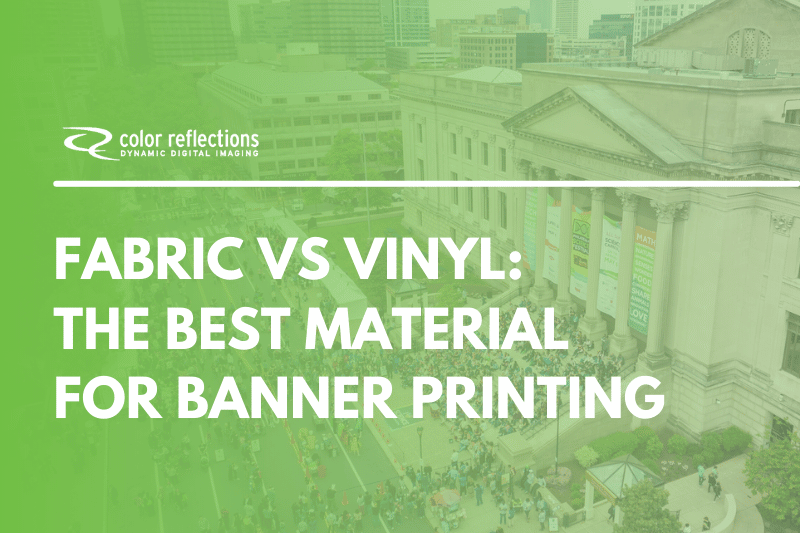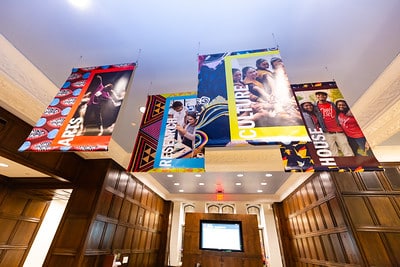Fabric vs. Vinyl: The Best Material For Banner Printing

Signs, banners, and custom wall graphics are some of the best ways to lure customers and build brand awareness. As more companies connect with customers in person now more than ever, creating an extraordinary experience is a must.
From outdoor banners and trade show displays, material matters when it comes to large-format printing. Vinyl and fabric banners are two of the most popular options, but let’s consider which works best for your design needs.
Walk through any retail space, drive through a busy downtown, or stroll through a sports arena and you’re likely to see various advertisements and branded signage. Large-format graphics are especially eye-catching. These digital prints can fill the sides of a tall building, serve as a backdrop during a special event, or redefine what a wall mural should look like.
They are meant to be durable, life-like, and can even be inclusive for the visually impaired. Some popular types of large-format graphics include:
Some graphic designers and printers swear by fabric banners, while others prefer vinyl signs. Both allow for brilliant colors and complex designs. In addition to the unique guidelines required for large-format printing, there are pros and cons to both vinyl and fabric materials.
Printing Vinyl Banners and Signs
Vinyl is by far the most popular material for banners and signs. It’s an excellent choice for indoor and outdoor use as it is naturally waterproof, fade-resistant, durable, and budget-friendly. It comes in various weights, the most popular being 13 oz. scrim, 15 oz. smooth, and 18 oz. pole.
Most banners are printed on calendared scrim vinyl. A molten plastic mix is rolled and pressed into a flat, stiff shape using a heavy roller or calender to create this thicker and more durable vinyl. A fabric mesh or scrim is sandwiched between 2 thin layers of vinyl. Calendared vinyl is also budget-friendly.
Pros of Vinyl Banners
- Vinyl is highly durable, holding up well under harsh weather conditions.
- Vinyl banners and signs are cheaper than fabric.
- Vinyl is easy to clean and maintain, and dirt and stains can be wiped down.
- Vinyl can be mounted via grommets.
Cons of Vinyl Banners
- Vinyl can be harder to transport, depending on size and weight. It will crease some when folded, so rolling is recommended, which can take up space and increase shipping costs.
- High-gloss vinyl banners have a natural sheen that reflects light, so they are not always preferred for photo backgrounds.
- Depending on your needs, vinyl is a heavier and 100% opaque material.

Printing Fabric Banners and Signs
Fabric looks elegant and expensive, elevating your banner. Most fabric banners are made from polyester because it allows for multiple printing methods, with dye sublimation being the most common. Fabric banners can also be printed with UV inks, silk screening, and latex inks.
The printing process also varies from vinyl, and they typically require specialized equipment and a knowledgeable printer. Graphic designs are applied to fabric banners through the following methods:
- Silk-Screening – Often seen with t-shirt printing, the design is framed in wood or metal, and special ink is pushed through the fabric mesh. This prevents the ink from passing through to the other side.
- Direct Print with UV or Latex Inks – Like most home and business printers, the ink is applied directly to the fabric using a digital printer.
- Dye Sublimation – The ink can be applied directly to the fabric or with a paper transfer. In both cases, the ink is heated to 400 degrees so it can be absorbed or “sublimated” and become part of the fabric.
Pros of Fabric Banners
- Fabric is more eco-friendly than vinyl banners and signs.
- Fabric can be folded and stored, making it easier to transport.
- Fabric can be washed when dirty.
- Fabric banners do not have a natural sheen like vinyl and absorb light, making them a better choice for step and repeats and flash photography.
- Fabric banners offer some transparency, allowing light to illuminate the design from behind.
- Fabric also absorbs sound, so these banners are an excellent option for events in large halls with hard floors and limited wall coverings.
Cons of Fabric Banners
- Even though technology has improved, making fabric cheaper, faster, and easier to produce, fabric banners are not always cost-effective as vinyl.
- Fabric banners and signs are not as hardy as vinyl when exposed to the weather.
- Fabric is not 100% opaque, so a double-sided design requires two banners to be welded or sewn together with a blackout piece in between.

When deciding on a large format print, the material is number one. But it’s not the only factor when choosing the type of sign you want to display. Here are five questions to ask yourself and your team before deciding which material will work best for your custom design.
1. Will Your Banner or Sign Be Indoors or Outdoors?
Your banner or signage location is a significant influencer of material. Outdoor event signs must be hardy enough to withstand weather elements such as rain, wind, snow, and sun exposure. Indoor event signs are protected from the weather, but lighting could become an issue, influencing color brightness and contrast
2. What Type of Design Is Your Banner or Sign?
Whether your sign or banner design is font-heavy, photo-realistic, texture-based, or accessible to the visually impaired, the material matters. Fabric and vinyl reflect light differently, feel different, and require specialized ink. Also, are your design colors set to CMYK or RGB? Certain materials may be better suited depending on the colors in your design.
3. How Big Is Your Banner or Sign?
The size of the banner will contribute to the weight. If your banner or sign is heavier, installation and how it will hang on the chosen backdrop should be considered. If you need a large banner and have limited display choices, a lighter material may be best. Ease of transport is also important when deciding on the size, meaning a more lightweight material is cheaper to ship.
4. What Is Your Budget For Your Banner or Sign?
Large-format graphic printing is cost more than standard printing. Size aside, fabric is more expensive than vinyl material. If your banner is less than five or six feet, you may be able to get the material you want and stay within your budget. But if your banner or sign is more than 100 feet, the price of the material could be the deciding factor.
5. Will Your Banner or Sign Be Stored?
Some banners and signs are seasonal, so they’ll need to be kept safe. In this case, your storage situation may be the deciding factor when it comes to material. If your storage area is limited, fabric banners can be folded and take up less space. The possibility of damage, exposure to mold, maintenance, and space are key factors when considering the material.
Not all printers that offer large-format printing services can work with a wide array of materials for large-format graphics printing. The Color Reflections team uses the very latest printing technology and can walk you through your choices. Plus, with five decades of experience, you can trust us to bring your vision to life. Contact our team for a quote today!
The post Fabric vs. Vinyl: The Best Material For Banner Printing appeared first on Large Format Printing & Event Graphics.
